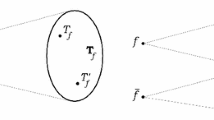Abstract
Existing literature implements the Dominant Energy Condition for dissipative fluids in general relativity. It is pointed out that this condition fails to forbid superluminal flows, which is what it is ultimately supposed to do. Tilted perfect fluids, which formally have the stress-energy tensor of imperfect fluids, are discussed for comparison.
Similar content being viewed by others
Data Availability
There are no data associated with this work because of its theoretical and mathematical nature.
Notes
We use the notation of Ref. [13], in which the metric has signature \({-}{+}{+}{+}\) and units are used in which the speed of light c and Newton’s constant G are unity.
At the time of writing, a cumulative citation count in Google Scholar returns 157 entries.
References
Rezzolla, L., Zanotti, O.: Relativistic Hydrodynamics. Oxford University Press, Oxford (2013)
Andersson, N., Comer, G.L.: Relativistic fluid dynamics: physics for many different scales. Living Rev. Rel. 24(1), 3 (2021). https://doi.org/10.1007/s41114-021-00031-6
Andersson, N.: Gravitational waves from instabilities in relativistic stars. Class. Quantum Grav. 20, R105 (2003). https://doi.org/10.1088/0264-9381/20/7/201
Maartens, R.: “Causal thermodynamics in relativity,” [arXiv:astro-ph/9609119 [astro-ph]]
Hiscock, W.A., Lindblom, L.: On transient relativistic thermodynamics and kinetic theory. II. Phys. Lett. A 131, 509 (1988)
Eckart, C.: The thermodynamics of irreversible processes. 3. Relativistic theory of the simple fluid. Phys. Rev. 58, 919–924 (1940). https://doi.org/10.1103/PhysRev.58.919
Müller, I.: Zum Paradox der Wärmeleitungstheorie. Z. Phys. 198, 329 (1967)
Stewart, J.M.: On transient relativistic thermodynamics and kinetic theory. Proc. R. Soc. Lond. Ser. A 357, 59 (1977)
Israel, W., Stewart, J.M.: Transient relativistic thermodynamics and kinetic theory. Ann. Phys. 118, 341–372 (1979). https://doi.org/10.1016/0003-4916(79)90130-1
Israel, W., Stewart, J.M.: On transient relativistic thermodynamics and kinetic theory. II. Proc. R. Soc. Lond. Ser. A 365, 43–52 (1979). https://doi.org/10.1098/rspa.1979.0005
Carter, B.: Convective variational approach to relativistic thermodynamics of dissipative fluids. Proc. R. Soc. Lond. Ser. A 433, 45 (1991). https://doi.org/10.1098/rspa.1991.0034
Müller, I., Ruggeri, T.: Rational Extended Thermodynamics, 2nd edn. Springer, New York (1998)
Wald, R.M.: General Relativity. Chicago University Press, Chicago (1984)
Carroll, S.M.: Spacetime and Geometry: An Introduction to General Relativity. Addison-Wesley, San Francisco (2004)
Hawking, S.W., Ellis, G.F.R.: The Large Scale Structure of Space-Time. Cambridge University Press, Cambridge (1972)
Borde, A.: Geodesic focusing, energy conditions and singularities. Class. Quantum Grav. 4, 343 (1987). https://doi.org/10.1088/0264-9381/4/2/015
Bekenstein, J.D.: Positiveness of Mass and the Strong Energy Condition. Int. J. Theor. Phys. 13, 317–321 (1975). https://doi.org/10.1007/BF01808371
Barcelo, C., Visser, M.: Twilight for the energy conditions? Int. J. Mod. Phys. D 11, 1553–1560 (2002). https://doi.org/10.1142/S0218271802002888
Martin-Moruno, P., Visser, M.: Classical and semi-classical energy conditions. Fundam. Theor. Phys. 189, 193–213 (2017). https://doi.org/10.1007/978-3-319-55182-1_9
Kolassis, C.A., Santos, N.O., Tsoubelis, D.: Energy conditions for an imperfect fluid. Class. Quantum Grav. 5, 1329–1338 (1988). https://doi.org/10.1088/0264-9381/5/10/011
Pimentel, O.M., González, G.A., Lora-Clavijo, F.D.: The energy-momentum tensor for a dissipative fluid in general relativity. Gen. Rel. Grav. 48(10), 124 (2016). https://doi.org/10.1007/s10714-016-2121-7
Setiawan, A.M., Sulaksono, A.: Anisotropic neutron stars and perfect fluid’s energy conditions. Eur. Phys. J. C 79(9), 755 (2019). https://doi.org/10.1140/epjc/s10052-019-7265-7
Ellis, G.F.R., Maartens, R., MacCallum, M.A.H.: Relativistic Cosmology. Cambridge University Press, Cambridge (2012)
Tsumura, K., Kunihiro, T.: Uniqueness of Landau-Lifshitz energy frame in relativistic dissipative hydrodynamics. Phys. Rev. E 87(5), 053008 (2013). https://doi.org/10.1103/PhysRevE.87.053008
Maartens, R., Gebbie, T., Ellis, G.F.R.: Covariant cosmic microwave background anisotropies. 2. Nonlinear dynamics. Phys. Rev. D 59, 083506 (1999). https://doi.org/10.1103/PhysRevD.59.083506
Clarkson, C.A., Coley, A.A., O’Neill, E.S.D., Sussman, R.A., Barrett, R.K.: Inhomogeneous cosmologies, the Copernican principle and the cosmic microwave background: More on the EGS theorem. Gen. Rel. Grav. 35, 969–990 (2003). https://doi.org/10.1023/A:1024094215852
Clarkson, C., Maartens, R.: Inhomogeneity and the foundations of concordance cosmology. Class. Quantum Grav. 27, 124008 (2010). https://doi.org/10.1088/0264-9381/27/12/124008
Acknowledgements
This work is supported, in part, by the Natural Sciences and Engineering Research Council of Canada (Grant 2016-03803 to V.F.).
Author information
Authors and Affiliations
Contributions
All authors contributed to the study conception and design.
Corresponding author
Ethics declarations
Conflict of interest
The authors declare no conflict of interest.
Additional information
Publisher's Note
Springer Nature remains neutral with regard to jurisdictional claims in published maps and institutional affiliations.
Rights and permissions
Springer Nature or its licensor (e.g. a society or other partner) holds exclusive rights to this article under a publishing agreement with the author(s) or other rightsholder(s); author self-archiving of the accepted manuscript version of this article is solely governed by the terms of such publishing agreement and applicable law.
About this article
Cite this article
Faraoni, V., Mokkedem, E.M.Z.R. Dominant energy condition and dissipative fluids in general relativity. Gen Relativ Gravit 55, 56 (2023). https://doi.org/10.1007/s10714-023-03110-x
Received:
Accepted:
Published:
DOI: https://doi.org/10.1007/s10714-023-03110-x



